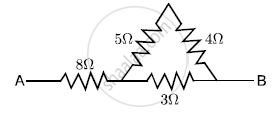Advertisements
Advertisements
प्रश्न
State Ohm’s law.
उत्तर
According to Ohm’s law, at a constant temperature, the steady current ‘I’ flowing through a conductor is directly proportional to the potential difference ‘V’ between the two ends of the conductor.
I ∝ V
V = IR.
APPEARS IN
संबंधित प्रश्न
Will current flow more easily through a thick wire or a thin wire of the same material, when connected to the same source? Why?
Why are coils of electric toasters and electric irons made of an alloy rather than a pure metal?
Write the SI unit of resistivity
When a 12 V battery is connected across an unknown resistor, there is a current of 2.5 mA in the circuit. Calculate the value of the resistance of the resistor.
The resistors R1, R2, R3 and R4 in the figure given below are all equal in value.

What would you expect the voltmeter A, B and C to read assuming that the connecting wires in the circuit have negligible resistance?
A wire of resistance 9 ohm having length 30 cm is tripled on itself. What is its new resistance?
Calculate the effective resistance across AB?

What are ohmic conductors? Give one exmaple. Draw a graph showing the current-voltage relationship for an ohmic conductor.

Calculate the total resistance of the circuit and find the total current in the circuit.
Suppose there is a circuit consisting of only resistances and batteries and we have to double (or increase it to n-times) all voltages and all resistances. Show that currents are unaltered. Do this for circuit of Example 3.7 in the NCERT Text Book for Class XII.
